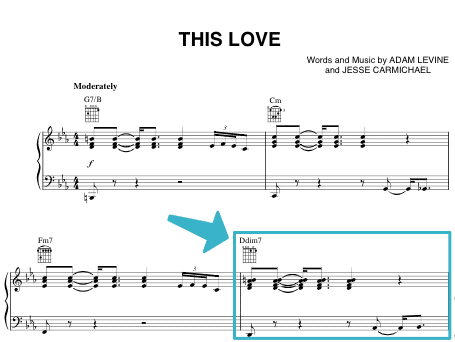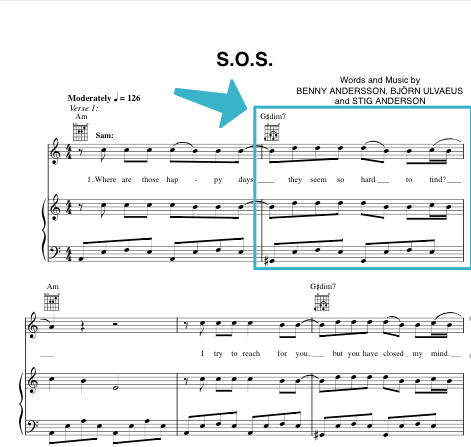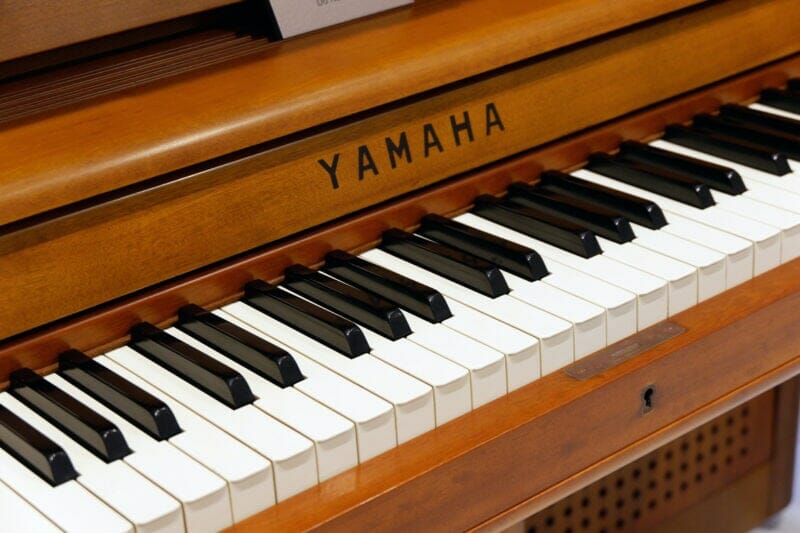Do you write songs that use chart-topping diatonic chords? (Those are chords built using notes of a major or natural minor scale.)
If so, there’s a chord that appears only once in the sequence.
It’s the diminished chord. Neither major nor minor but diminished.
The symbol for the diminished chord is a superscript circle above the letter of the chord. C° or just the rather insulting shorthand, dim: Cdim.
It can be tricky to know how to use it in a song. Plenty of songwriters, even chart toppers, never even bother.
I think that’s sad because a diminished chord adds serious flavor to your catalog. Making your songs sound super fresh!
What Makes a Diminished Chord?
A diminished chord uses a basic triad—three notes—stacked in intervals of two minor thirds.
Just like minor chords, the diminished chord has a flattened or minor third (♭3).
But its special diminished sound comes from the flattened or diminished fifth (♭5). Also known as the tritone.
Have a listen.

The name diminished refers to the interval between the root note (R) and the fifth note (dim5 or ♭5) in the chord.
It’s smaller compared with major and minor chords. That’s what diminishing means—making something smaller.
Yet the sound of the diminished chord has been variously described. Dissonant, unstable, tense, disruptive, and even scary!
Boo hoo.
But it’s exactly those qualities that make diminished chords so helpful in chord progressions. They deliver surprise and drama.
Boom!
Two Examples in Real Life – Maroon 5 and ABBA
You can hear a diminished chord here. It’s the fourth chord in this introduction/verse chord progression of Maroon 5’s hit “This Love.”

Meanwhile, in ABBA’s “SOS,” you can hear the diminished chord appear as the second chord when the verse starts.

Both these examples show two helpful rules of thumb for using diminished chords in songs.
- A little goes a long way
- It’s neither a starter nor a finisher
They also raise a really common point.
Popular songs rarely use the diminished chord as a plain triad or full diminished. Instead they use the diminished seventh—Ddim7 in “This Love” and G♯dim7 in “SOS.”
You make a diminished seventh by stacking another minor third on top of your diminished triad.
It has this unfortunate makeup:
- 1 or R root note
- minor third ♭3
- flat or diminished fifth ♭5
- double flatted or diminished seventh ♭♭7
Now before you lose the will to live with that mouthful…
Remember the chord is just three minor thirds stacked on top of each other, which looks like this.

And sounds like this.
On a keyboard, Cdim7 looks like this, and you can see each note is three half-steps or a minor third apart.
This makes a little more sense of the ♭♭7!

On guitar, Cdim7 looks like this.

The diminished seventh has a party trick. Because each of the notes is a minor third apart, you can use any of the notes as the start or root note.
So Cdim7 is also E♭dim7, G♭dim7, and even B♭♭dim7 (Adim7). And you can play that shape up the fretboard every three frets, which sounds like this.
Working with Diminished Sevenths
1. Tension
There are four notes in a diminished seventh chord, whatever the key. They wind up acting as a pull or leading note to either a major or minor chord a half-step or fret above.
Now this chord becomes super useful as the tension before a resolution (the storm before the calm!)
So you could follow Cdim7 with C♯ major—a major chord a half-step up.
Or you could follow Cdim7 with E minor—because E minor is a half-step up from the third note of the chord E♭.
2. Replace the V chord
You can also try replacing the archetypal V chord with a diminished seventh.
Say your song is in C major (I), and F major is your IV. Instead of the G major (V) as the penultimate chord, you can use C♯dim7 for an interesting twist.
Confession: I can tell that it works shamefacedly. Because I did it in complete ignorance in the first song I wrote that finally used a dim seventh.
3. Connectors and transitions
You can insert a diminished seventh between any two chords in your song’s progression that are a whole step apart—major or minor. Put it on the half-step between.
Garth Brooks does this famously in his song “Friends in Low Places.” And his use of this technique made me reappraise his songwriting.
This song is in A major and starts on A major (1) followed by A♯dim7 resolving to B minor.
A /// A♯dim7/// Bm///
I ii
George Harrison does it 26 seconds into “My Sweet Lord.” It’s a half-step guitar sliding riff on Fdim7 between E major and F♯ minor.
If George can do it, so can you.
Tonic with a gin dim7
One use that’s pretty arresting is moving from the i chord (tonic) in a minor progression to idim7 (and that’s the gin!).
It’s called common tone diminished progression. Because both chords wind up prolonging the tonic or root note.
Dream Theater shows how effective this can be in their cinematic song “Fatal Tragedy.”
Conclusion
There’s a great deal to be said about these interesting chords, but this is a scratch on the surface.
The main thing is to try using a diminished seventh at some stage in your career. Even if you don’t release it.
Diminished chords are part of some of the top artists’ songwriting arsenals. From the relentlessly adventurous Beatles to worldwide sensation Adele.
All you have to do is unpack the minor third stack that creates a diminished seventh.









